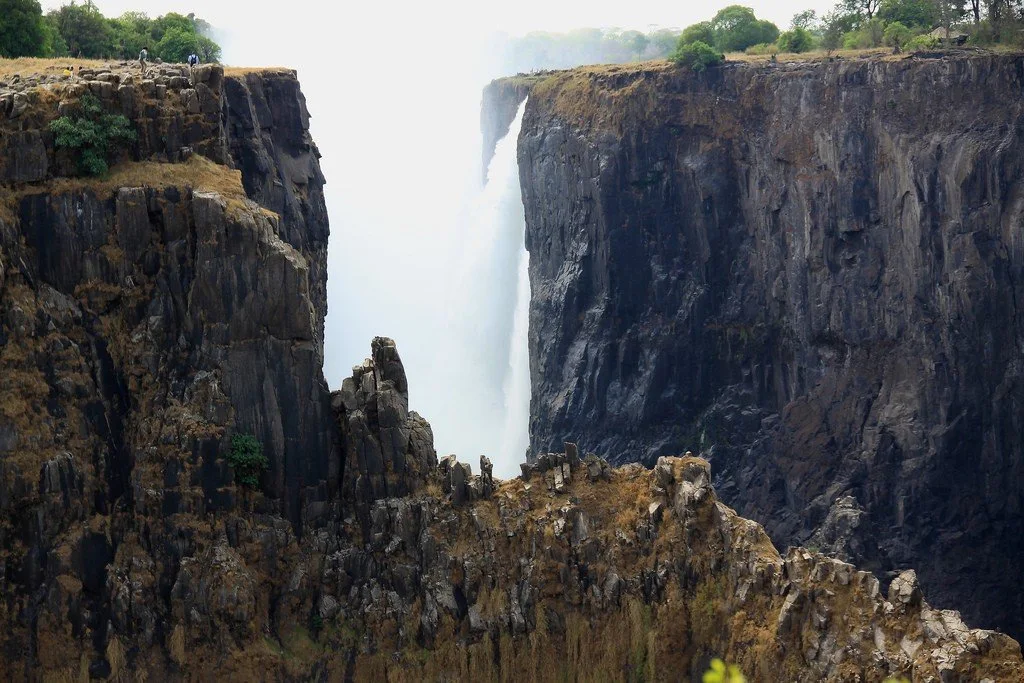Victoria Falls is a stunning natural phenomenon located on the Zambezi River on the border of Zambia and Zimbabwe, 18 km south of Livingstone.
 |
| Victoria Falls |
Basic moments
The Kololo tribe that lived in these places in the 1800s called the Mozi-oa-Tunya Falls, Thundering Smoke, or The Biggest Curtain of Falling Water. The majestic Victoria Falls, or rather, a huge cloud of spray rising above it, can be seen from a distance of 64 km, as the water rushes vertically down from a height of 100 m.At the peak of the rainy season, 546 million cubic meters of water rushes every minute into a 2 km wide rupture of basalt rocks. At this point, the Zambezi from a calm and shallow river turns into a real hell of boiling water.
 |
| Victoria Falls |
Dr. David Livingston, the first European to visit Victoria Falls, named this natural phenomenon in honor of the Queen of England. In the humid, foggy rain forest at the top of the waterfall, a path is laid from which a brave visitor, not afraid to get wet to the skin in a huge cloud of spray, can enjoy an incredible sight.
The waterfall is extremely wide, approximately 1800 meters wide, the height of the fall of the water varies from 80 meters at the right bank of the waterfall to 108 meters in the center. Victoria Falls is about twice the height of Niagara Falls and more than twice as wide as its main part ("Horseshoe"). Falling water creates spray and fog that can rise to heights of 400 meters and more. The fog created by the waterfall is visible at a distance of up to 50 kilometers.
Victoria Falls is divided into four parts by islands on the edge of the abyss. Near the right bank of the river there is an inclined stream 35 meters wide, called "jumping water", then behind the island of Boaruka (300 meters wide) there is a main waterfall with a width of about 460 meters. Livingstone Island separates the main waterfall from the second stream (approximately 530 meters wide), at the very left bank of the river is the eastern waterfall.
 |
| Victoria Falls |
The only way out of the crevice where the water is now falling is a rather narrow channel pierced by water in its wall at about 2/3 of the distance from the western end. This channel is approximately 30 meters wide. The entire volume of water passes through it for about 120 meters, after which the river falls into a zigzag gorge. The river does not leave this gorge for about 80 km, until it leaves the basalt plateau.
Tourists
In order to appreciate the incredible size of the waterfall and the gigantic power of the water that has carved deep gorges at a distance of 8 km, you need to view the waterfall from the air or, if you prefer, from the raft below. Pilots fly over the Upper Zambezi and descend into the gorges - you can hardly ever forget this amazing feeling.
Another vantage point for observation is on the other side of the Knife's Edge Bridge, which was built in 1900 by order of Cecil Rhodes. There is also a "lookout tree" from where you can admire the panoramic views of the falls and fully appreciate the thundering splendor. The combination of the dark green river below the glittering rock and emerald green foliage makes the spectacle truly unforgettable.
 |
| Victoria Falls |
Immediately after the waterfall, a section of the river with numerous rapids begins, which attracts fans of kayaking and rafting. The rapids are safe enough for novice tourists, with a large flow of water there are no dangerous stones, and after all the rapids there are sections of smooth water.
Zimbabwe and Zambia allow for day-trip visas when crossing borders without prior application, however these visas are considered expensive.
